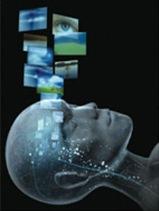Mindscapes: Stroke turned ex-con into rhyming painter
Not only did he feel a sudden urge to write poetry, but he also began to paint and draw obsessively for up to 19 hours a day. He was never artistic before – in fact, he joked that he'd never even been in an art gallery "except to maybe steal something". Desperate to find out what was going on, Tommy wrote to several neuroscientists and end up working closely with Alice Flaherty at Harvard Medical School and Mark Lythgoe at University College London.
Going Zen
Flaherty says the haemorrhage sent blood squirting around the brain surface, affecting a lot of areas. It left Tommy unusually emotional and unable to hurt anyone, "like Zen monks sweeping steps before they walk," says Flaherty. "Everything strikes him as beautiful and cosmically meaningful."
Scanning Tommy's brain was impossible after an operation to treat the stroke damage left him with a piece of metal in his head. Instead, Lythgoe performed a neuropsychological evaluation. Tommy's IQ was in the normal range. However, he showed verbal disinhibition – he tended to talk a lot – and had difficulty with tests that required him to switch between different cognitive tasks. All of which suggested problems with the frontal lobes.
The frontal lobes play a vital role in abstract thought and creativity. They are constantly bombarded with raw sensory data from the world around us, most of which is deemed irrelevant by the brain and screened from conscious awareness. Blocking this inhibition using magnetic pulses can make people more creative, even unleashing savant-like skills.
"That's what Tommy's mind does all the time," says Lythgoe. Everything he heard and saw triggered a stream of associations that he found difficult to stop. Tommy saw it as having a brain that shows him "endless, endless corridors". He said his paintings represented a snapshot of a millisecond in his brain.
"I'll paint three or six or nine pictures at a time. I see those numbers in my head all the time. Canvases became too costly, so I started painting the ceilings and the wallpaper and the floor. I can't stop painting and sculpting. Give me a mountain and I'll turn it into a profile. If you give me a bare tree I'll change it, so when spring come all the leaves will create the face, the mouth, the lips. Without hurting the tree."
Offering advice for others with brain damage, he said that people who have had strokes need to learn not to think of themselves as ill, with the dangers of depression that can bring. "Some repairs to the brain are constructive, some are negative. One has to learn to develop one's damaged brain, adapt and start to live again. You can either sit on your bum or look in the mirror and say 'I'm alive'."
He wouldn't even have wanted his old mind back: "The most wonderful thing that happened to Tommy McHugh," he laughed, "is having a stroke while doing a poo." He wouldn't have changed a thing. "My two strokes have given me 11 years of a magnificent adventure that nobody could have expected."
Helen Thomson
www.newscientist.com
Tommy McHugh passed away on 19 September 2012, having spoken to New Scientist several times that year. Samples of his artwork can be viewed on his website.

